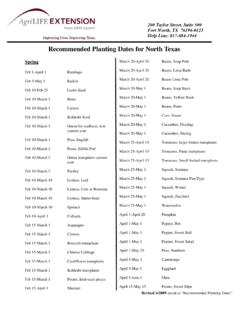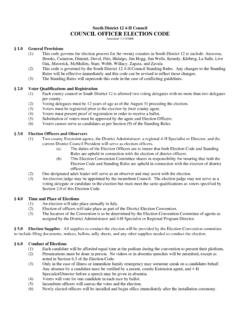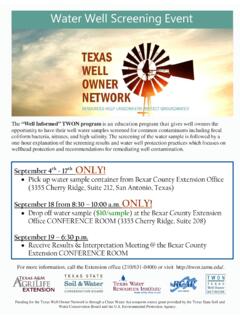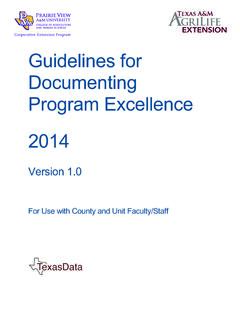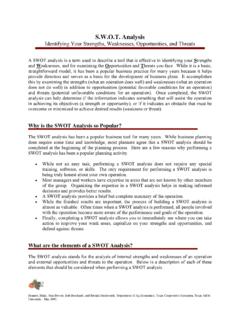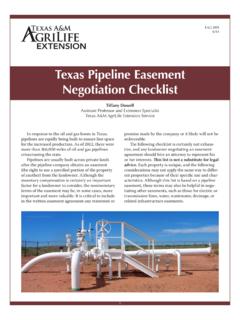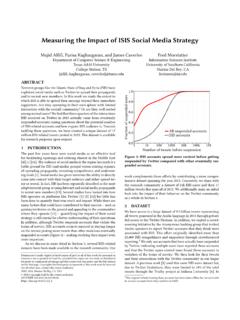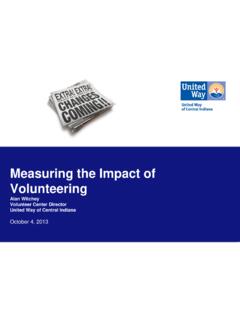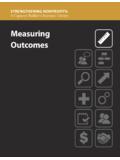Transcription of Measuring the Economic Impact of Park and …
1 Measuring the Economic Impact of Park and Recreation ServicesPrepared for: The National Recreation & ParkAssociationPrepared by:John Crompton, A&M UniversityTable of ContentsChapter 1 ..3 Why Economic Impact Studies Are a Key to a Viable Future ..3 The Rationale for Economic Impact Studies ..3 The Central Role of Economic Impact in the Formative Era of Park Development .. 6 The Central Role of Economics in Launching Public Recreation ..8 Positioning Park and Recreation Agencies as Engines of Tourism ..9 Using Economic Impact Studies to Reposition the Field ..13 Chapter 2 ..17 The Fundamental Principles of Economic Impact Studies ..17 Accurate Participation Numbers ..18 Exclusion of Local Residents ..19 Spurious Rationales ..21 The Deflected Impact Caveat ..22 Inappropriate Aggregation ..22 Exclusion of Time-Switchers and Casuals ..23 Differentiating Economic Impact and Economic Significance Studies.
2 24 Chapter 3 ..28 Collecting Visitors Expenditure Information ..28 Chapter 4 ..34 Use and Abuse of Multipliers ..34 The Multiplier Concept ..34 Constituent Elements of a Multiplier ..36 Operationalization of the Multiplier ..37 Capture Rates ..38 The Influence of a Community s Size and Business Structure on Multipliers ..38 Interpreting Different Types of Multipliers ..41 Interpreting Employment Multipliers ..42 Using and Interpreting IMPLAN ..42An Illustration of the Implications of Abusing the Fundamental Principles of Economic Impact Analysis and Multipliers ..43 Chapter 5 ..47 Consideration of Costs ..47 Event Costs ..47 Infrastructure Costs ..47 Displacement Costs ..49 Opportunity Costs ..49 Chapter 6 ..52 Principles Illustrated in Results from a Selection of Park and Recreation Department Economic Impact Studies ..52 Sports Tournaments ..52 Special Events.
3 52 Recreation Facilities ..56 Park Facilities ..56 Development of an Annual Economic Impact Report ..56 NRPA Measuring the Economic Impact of Park and Recreation Service 12 NRPA Measuring the Economic Impact of Park and Recreation ServiceExecutive SummaryTourism depends on attractions . Rarely do people travel because they enjoy the car or airplane ride or because they want to stay in a particular hotel or dine at a restaurant in a different city . The desire to go to another place is stimulated by attractions . In most communities, primary attractions are sports tournaments, festivals, parks, and major recreation facilities operated by park and recreation departments . However, most stakeholders remain unaware of park and recreation departments role in tourism .Park and recreation departments frequently are viewed as relatively high-cost centers in cities annual budgets because operational costs exceed revenues.
4 However, this narrow perspective is incomplete because it fails to recognize that money invested in park and recreation department services does not belong to the city council, rather it belongs to the city s residents . The purpose of Economic Impact studies is to measure the Economic return that residents (rather than the city council) receive on their investments . For example, a representative illustration in this monograph shows that residents in a city who invested $24 million in a new sports facility will get their money back on this investment in approximately 13 years from income they receive as a consequence of spending by visitors attracted to the community by that facility . This monograph provides a hands-on guide for professionals so they can do Economic Impact studies that measure the Economic return residents receive on park and recreation department investments.
5 These studies are relatively simple to do, and they do not require hiring external consultants . Park and recreation department personnel can do these studies in house at nominal cost in time and resources . A one-page questionnaire used to collect the data is provided . Examples of how to effectively present the information to stakeholders are given .The Economic Impact of visitor spending is estimated by the formula: number of visitors x average spending per visitor x multiplier . This formula indicates there are four steps involved: (1) define who qualifies as a visitor; (2) estimate the number of visitors attracted to the community by the park and recreation event or facility; (3) estimate the average level of spending of visitors in the local area; and (4) determine the ripple effects of this new money through the community by applying appropriate multipliers .The monograph guides professionals through these stages.
6 Economic Impact studies are used widely in contexts such as Economic development, tourism, housing development, and professional sports stadia . Unfortunately, there has been a growing tendency to adopt inappropriate procedures and assumptions in many of these studies to generate high Economic Impact numbers that legitimize a particular advocacy position . These failings are discussed in the monograph and direction on how to avoid them is presented . The numbers emerging from an Economic Impact study represent only the gross Economic Impact . However, community stakeholders are likely to be more concerned with net Economic benefit, meaning that costs associated with the facility and event must be identified and deducted . The four types of costs and the nature and implications of each are described: event costs, infrastructure costs, displacement costs, and opportunity costs.
7 Finally, the monograph reports the results of more than 100 Economic Impact analyses undertaken by the author s research team in the past decade at sports tournaments, special events, recreation facilities, and park facilities . Patterns in these results that illustrate generalizable principles are described . The Economic Impact of events and facilities will differ widely because of differences in local contexts . Nevertheless, in communities where managers have no empirical data but are required by stakeholders to give estimates of visitors expenditures and Economic Impact , the results of these case studies suggest parameters for providing intelligent guesses . NRPA Measuring the Economic Impact of Park and Recreation Service 3 Chapter 1 Why Economic Impact Studies Are a Key to a Viable FutureThis chapter explains the conceptual rationale for Economic Impact studies.
8 An understanding of this is critical because it is the shared ground between professionals and policy makers that enables them to arrive at a mutual understanding of the core point . They then become partners on a common journey to see how the research evidence speaks to the issue . A conceptual understanding of the principles results in the scientific evidence being much more understandable and acceptable to elected officials . The subsequent chapters are hands on . They describe the fundamental principles of Economic Impact studies, provide a step-by-step guide for professionals on how to collect visitor expenditure information, discuss the use and abuse of multipliers, and consider Economic costs . The final chapter offers a synopsis of results from completed Economic Impact studies, and it suggests generalizations of the likely magnitude of Economic Impact associated with various kinds of park and recreation facilities, events, and services.
9 The Rationale for Economic Impact StudiesWhen the park and recreation department in city A reported the financial consequences of hosting a national softball championship tournament, it reported a loss of $79,717 . When the convention and visitors bureau, which was responsible for promoting tourism in that community, reported the consequences of hosting the same event, it reported an Economic gain to the community of $3 .7 million . It is obvious which of these two agencies was likely to be viewed most positively by elected officials and taxpayers .Why did two agencies report such disparate data from the same event? The answer: they used different approaches for demonstrating accountability for their public funds .Park and recreation agencies traditionally have provided financial reports, while the tradition in the tourism field has been to provide Economic reports . The different reporting methods have resulted in the two types of agencies occupying very different positions in the minds of public officials.
10 By using Economic reports, many convention and visitor bureaus have persuaded elected officials and decision makers that they are central contributors to their communities Economic health . In contrast, park and recreation agencies generally have not been successful in creating a similar central position in decision makers minds regarding the Economic contribution of their services because they have used only financial reports . In a climate of fiscal conservatism, park and recreation agencies are mistakenly perceived to be black hats whose services have to be subsidized by tax funds and result in net Economic losses to the community, while convention and visitor bureaus have established themselves as white hats because they bring new money into the community . These perspectives are fallacious . To change the perspectives and to reposition park and recreation agencies more favorably, these agencies must emulate the methods used by tourism agencies and identify the Economic Impact that is attributable to the facilities and services they provide.
